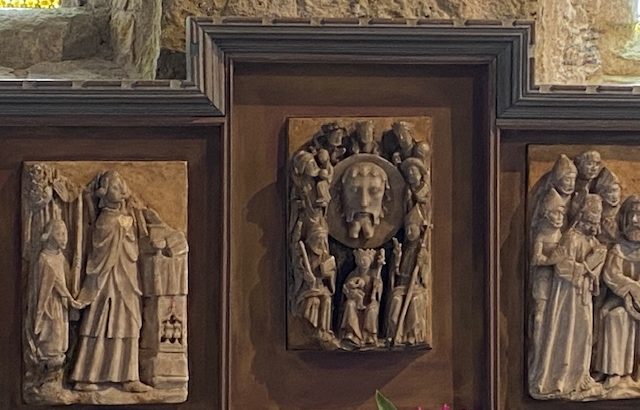I write on 17 May in the Year of Grace, 2022, from Marazion, Cornwall, within sight of the former Benedictine monastery of Mount St Michael. To keep this short, it is a wonderful place to visit and to pray.
There is today, sadly, only one sole altar, and that is a late addition. At the Devastation of Monastic England (a.k.a. the “dissolution of the monasteries” a heavy duty euphemism), the many consecrated altars there were doubtless destroyed. I am told the chapel was used as a storage area.
Well, when the descendants of the new owners “restored it” (partially), they brought in an altar and an altar carving. It is known that it was a late medieval or very early modern one from Catholic Europe. It is not original. See the illustration herewith. I was assured that the central panel depicted the head of St John the Baptist.
In my view, this is quite wrong. I am sure that the triptych of carvings above the altar form a coherent whole, based around the Catholic doctrine of the Mass as being the true sacrifice of Our Lord. This means that the central panel is itself based around the depiction of the Lord upon the Eucharistic Paten (the round golden plate the priest uses at Mass). It is not, therefore, the head of John the Baptist. I am fairly sure about this, and say it for the following reasons:
- The distinctive forked beard of the face which is engraved upon the disk, is the beard of the man standing before Pontius Pilate in the left hand carving (Catholic altars are construed from the position of the crucifix which would be placed centrally, looking into the nave). When you have once seen this, the identity of the head in the left hand carving and the face in the centre becomes apparent. As the man arraigned before Pilate must be Jesus, who is washing his hands, then the face upon the disk must be that of Jesus. The similarity of the beard on the carving with that in a 15th century head of Our Lord is striking.
- The Mass in the scene at the right is shown at the very moment of Transubstantiation of the Body of the Lord, when the priest is holding aloft the Paten having spoken the words of consecration. The altar server is holding up the hem of the priest’s chasuble, which only ever occurs at what we call the elevations, when the paten and the chalice are being held aloft as an oblation to God and as a sign to the congregation, should there be one. As the chalice is clearly shown on the altar itself, the priest must be holding aloft the paten on which is the now consecrated Host, i.e. the body of Our Lord.
- The central panel has, around the disk, a number of images. To the extent I can be sure, these relate to the Lord, none to St John the Baptist. For example, immediately below the Holy Face is Our Lady holding the Child Jesus, and at the very top are the three Wise Men, shown by their crowns and the gifts they bring. After that, it is unclear, to her right is probably St Peter (if those are keys), to her left is probably St Paul (shown as a bishop, with the tau staff known from the East, i.e. with authority to teach, but also because it is St Paul in 1 Corinthians who tells us more about the Eucharistic Sacrifice and its meaning than anyone else). I think the figure on the middle right is either St Joseph or St Christopher carrying the child Jesus. The other figure is one I cannot even guess at. However, those three figures may not be Ss Peter, Paul, and Christopher. They could be figures associated with the production of the carving.
- St John the Baptist has nothing to do with altars and altar pieces, at least not so centrally. But Jesus mist definitely does.
- This way, read from the centre: the triptych is about the Eucharistic sacrifice of the Mass. On the left, the historical context, when Our Lord sacrificed Himself; and on the right, the liturgical context, when He is again sacrificed through the medium of His priest. That is actually the Catholic theology of the Mass.
Now, for comparative art, I am not at home with my library, but this fourth century Spanish paten shows Our Lord with Ss Peter and Paul: https://www.thelocal.es/20141002/4th-century-glass-plate-of-jesus-unearthed-in-spain-paten/
Depicting Our Lord with a forked beard is a feature of Syriac art, but is not exclusive to it http://theshroudofturin.blogspot.com/2008/07/re-middle-eastern-features-on-shroud.html
The tau cross, too, was originally Eastern but then spread: http://franciscanseculars.com/history-of-the-tau/
May St Michael the Archangel care for the Church, protect us from Satan, and restore the faith across the globe.
